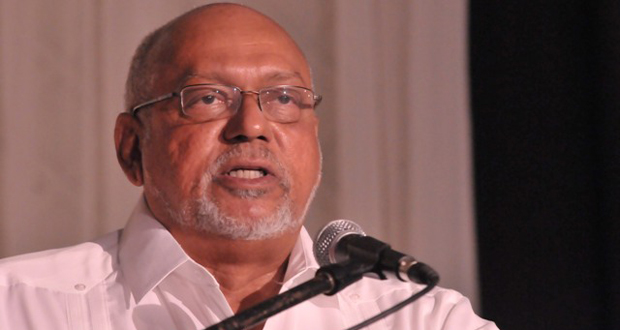
President Ramotar… Were it not for setbacks caused by combined Opposition –US$800M could have been invested in Amaila
–but hydropower can be a reality by 2019
AN accumulated US$80M in payments from Norway (US$45M of which was released in 2013 and the remaining US$35M on Friday) will be transferred to the Inter-American Development Bank (IDB) to be used as Guyana’s equity contribution to the Government’s Amaila Falls Hydro-power Project (AFHP).
And President Donald Ramotar contends that were it not for setbacks caused by the combined Opposition’s disposition towards the project, an additional US$800M in foreign direct investment could have already been invested in the project.
“The US$80 million of the money received from Norway should by now have been invested in the flagship of the LCDS, the Amaila Falls Hydro Project. This would have attracted more than US$800 million in further financing from foreign direct investment,” he said on Friday evening in an address to the nation.
To this end, the President stressed the need for Guyanese to insist on the cessation of “partisan” attacks that will destroy a project that is critical to Guyana’s development.
“I call on the people of Guyana to insist on no more partisan attacks to destroy something that is so critical to our country’s development, but instead, to insist on a constant debate on how we can work together on these matters of crucial national importance,” he said.
SELF-SERVING POLITICS
According to the Head of State, “self-serving political games” advanced by the combined Opposition, A Partnership for National Unity (APNU) and the Alliance For Change (AFC), resulted in an attempt to destroy the project, which would have provided all Guyanese with affordable, reliable and clean energy.
“The attempt to cause the collapse of the Amaila Falls Hydro Project in August 2013 was a disgraceful episode in our nation’s development, when some commentators and politicians refused to let evidence be their guide. We saw untruthful statements from people who had access to all the relevant information which proved their own statements wrong,” Mr. Ramotar said.
On July 18, 2013, the combined Opposition in Parliament defeated the Hydroelectric Power (Amendment) Bill in the National Assembly, and in August the Government took the legislation back to the House and received the backing of the AFC, but A Partnership for National Unity (APNU) voted down the bill and motion.
Additionally, in 2014, the allocation of $1.3B for the provision of the Amaila access road and related structures was effectively given the green light from the Parliamentary Committee of Supply, in its review of the Ministry of Public Works’ 2014 budgetary allocation, in April this year.
When the bill was put to the vote, Members of Parliament (MPs), from the Government voted in support of the ministry’s capital expenditures, which included the Amaila project, A Partnership for National Unity (APNU) voted no and the Alliance For Change (AFC) abstained. It was only this abstention that allowed the project to go through.
MAINTAINED COMMITMENT
Regardless of the challenges, the President reiterated his commitment to the crucial, transformative project.
He said, “I said then (in 2013) that I would not give up in the face of such baseless attacks and that my Government would remain steadfast in pursuing this transformative project.
“Thankfully, our partners in the Inter-American Development Bank and the Government of Norway also remained steadfast in their resolve, and I am pleased to let you know that we are once more making progress.”
Slated to be this nation’s most ambitious undertaking, the Amaila Falls Hydro Project (AFHP) is touted to be able to provide Guyanese with a cheaper, reliable and sustainable electricity supply. It involves the construction of a hydropower plant in the area of West-Central Guyana, where the Amaila and Kuribrong Rivers meet. Electricity produced there would be delivered to Georgetown and Guyana’s second largest town, Linden.
Mr. Ramotar’s consistent position on the matter is that economies must serve the people, not vice-versa, and with an expected saving of $9B in electricity subsidies, as well as savings on the $40B fuel bill, enormous contributions can be made to the infrastructural development, which is particularly needed in Guyana’s hinterland to aid and accelerate economic progress.
Details on the way forward with the project are expected to be released in the coming weeks.
“We can never make back the time that we have lost, but the Amaila Falls Hydro Project can still be operational by 2019,” Mr. Ramotar assured.
To date a total of US$150M, US$70M invested in LCDS projects and US$80M for AFHP, has been paid over to Guyana by Norway. The payments represent payments for climate services and continued low deforestation, as part of the country’s Low-Carbon Development Strategy (LCDS) up to 2012.
(By Vanessa Narine)


